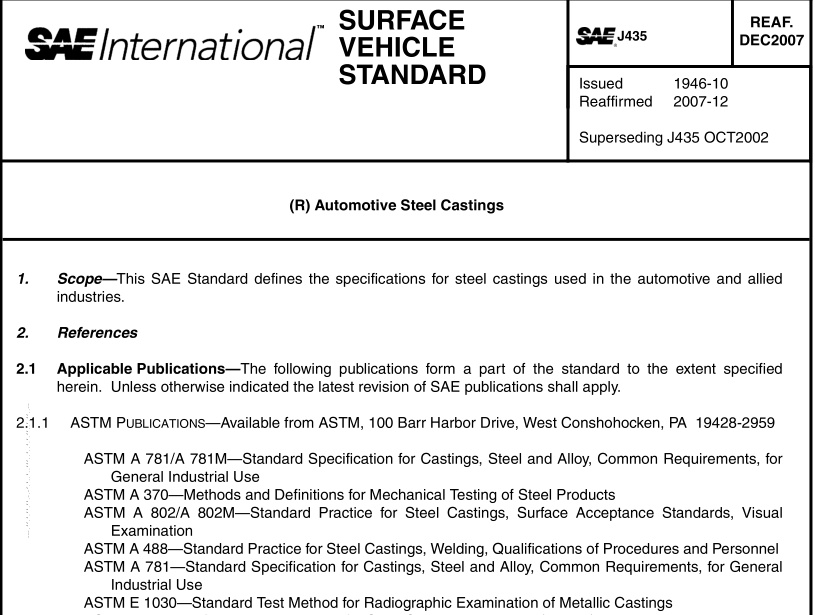SAE J435:2002 pdf download Automotive Steel Castings
4.2 When not specified in Table 1 the content of carbon, manganese, silicon, and alloying elements may, by agreement, be prescribed by the purchaser. If not specified, the content may be selected by the manufacturer to obtain the required mechanical properties or hardenability.
5. Heat Treatment—All castings shall be supplied in the heat treated condition. The heat treatment procedure may be specified by the purchaser in a written agreement with the supplier. Unless otherwise specified, the supplier may choose to heat treat the castings by one or more of the following processes; annealing, normalizing, normalizing and tempering or quenching and tempering. In the event of a change in the heat treatment procedure the requirements of Section 6 must be met.
6. Mechanical Properties
6.1 Mechanical testing from separately cast test bars shall be carried out in accordance with ASTM A370. The mechanical properties shall comply with the requirements of Table 1 . The test bars shall be heat treated in production furnaces. Test bars shall be heat treated to the same procedure as the castings they represent.
6.2 Product Testing—Subject to agreement between the purchaser and supplier, test bars may be taken from the castings. The location and the required mechanical properties are subject to agreement between the purchaser and supplier. 7. Frequency of Testing
7.1 Following the satisfactory achievement of the required mechanical properties of ten consecutive heats from any one grade, succeeding heats from the same grades may be qualified by hardness testing providing they fall within the range of compositions of the original 10 heats. The castings in each heat will be accepted by hardness testing of one test bar from each heat. If the purchaser wishes to substitute complete mechanical testing then supplementary requirement 1 0.1 should be specified.
7.2 Retests—If any specimen shows defective machining, or exhibits flaws, it may be discarded and another substituted from the same heat.
8. Inspection
8.1 Minor discontinuities—The surface of the casting shall be free of adhering sand, scale, cracks and hot tears as determined by visual examination. Other surface discontinuities shall meet the visual acceptance standards specified in the order. Practice ASTM A 802/A 802M or other visual standards such as MSS SP-55 may be used to define acceptable surface discontinuities and finish. Unacceptable visual surface discontinuities shall be removed and their removal verified by visual examination of the resultant cavities.
SAE J435:2002 pdf download
